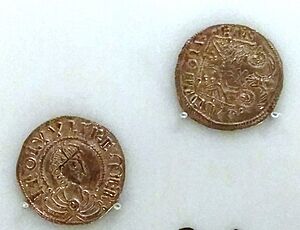Ceolwulf II of Mercia facts for kids
Ceolwulf II was the last king of an independent kingdom called Mercia. He became king in 874 after the Vikings removed the previous king, Burgred of Mercia. Ceolwulf II ruled for about five years, from 874 to around 879. Some historians think he might have ruled a bit longer, into the early 880s. By 883, a new ruler named Æthelred took over Mercia with the help of Alfred the Great, who was the powerful king of Wessex.
Contents
Who Was Ceolwulf II?
Historians believe Ceolwulf II belonged to a royal family known as the 'C' dynasty. This family claimed to be descendants of an earlier Mercian king named Pybba of Mercia. The 'C' dynasty, which included kings like Coenwulf, might have also had connections to the ruling family of a region called Hwicce in southwest Mercia.
Even though we don't know exactly who his parents were, it's thought that Ceolwulf was a descendant of King Ceolwulf I. This means he came from a long line of kings. Many important nobles, called thegns, who served King Burgred also served Ceolwulf. Even Mercian bishops supported him, showing that he was accepted as the true king of Mercia.
Mercia, Wessex, and the Vikings
The Anglo-Saxon Chronicle is an old historical record. It tells us that in 874, the Viking army went to Repton. They forced King Burgred to leave Mercia and took over the land. The Chronicle then says that the Vikings gave the Mercian kingdom to Ceolwulf. It describes him as "an unwise king's thane" (a noble who served the king). It also says he swore oaths to the Vikings and promised to help them whenever they needed him.
However, the Anglo-Saxon Chronicle was written for Alfred the Great. Alfred was King Burgred's brother-in-law. Because of this, many historians think the Chronicle's story about Ceolwulf is biased. It might have been written to make Alfred look more powerful and to make Ceolwulf seem less important.
A discovery in 2015 helped change this view. A collection of coins, called the Herefordshire Hoard, was found. These coins were made around 879 CE. They show both Ceolwulf as a king and Alfred. This suggests that Ceolwulf and Alfred were seen as equals at the time. Experts now believe these coins help us understand history better. They show that Ceolwulf was a real king, not just a puppet of the Vikings.
It is believed that Ceolwulf's kingdom was smaller than before. It probably included only the northern and western parts of Mercia.
Battles in Wales
In 878, King Rhodri Mawr of Gwynedd in Wales was killed in a battle against the English. At this time, King Alfred was busy fighting the Vikings. Mercia had traditionally controlled parts of Wales. So, it's likely that Ceolwulf was the English leader who fought against Rhodri.
Later, in 881, Rhodri's sons defeated the Mercians at the Battle of the Conwy. Welsh records called this victory "revenge of God for Rhodri." The Mercian leader in this battle was probably Æthelred, who became the ruler of Mercia after Ceolwulf.
Coins and London
We know about Ceolwulf II from the coins that were made during his reign. Three different types of coins, called pennies, have been found with his name on them. Most of these coins were made in London. They were a special type called Cross-and-Lozenge coins. Interestingly, King Alfred of Wessex also used this same coin design.
Because their coins were so similar, some historians think that Ceolwulf and Alfred worked together. They might have cooperated to fight against the Vikings.
At first, some experts thought that Alfred was the only ruler recognized in London around 875. They believed Ceolwulf's involvement came later, near the end of his reign in 879. However, in 1998, another Cross-and-Lozenge penny with Ceolwulf's name was found. This coin seems to be from the same time as Alfred's earliest coins. This discovery further supports the idea that they were working together from early on.
In 2015, a large collection of coins, jewelry, and silver was found near Watlington in Oxfordshire. This find, called the Watlington Hoard, dates back to the 870s. It included coins that showed two Roman emperors, along with the name of either Alfred or Ceolwulf. This hoard provides more evidence that Ceolwulf was a powerful king who ruled alongside Alfred.
See also


